Demographic situation
The Grand Duchy of Luxembourg is situated in the middle of Western Europe between Belgium, France and Germany. With a surface area of 2 586 km2, the country stretches from North to South over a maximum distance of 82 km.
Population
According to the National Institute of Statistics and Economic Studies (STATEC), there were 634 730 inhabitants on 1 January 2021. Luxembourg's resident population has been consistently growing in the course of the last 30 years (in 1988, there were 372 000 inhabitants). This increase is mainly due to immigration (STATEC).

(Source: STATEC, 2021, Luxembourg in figures)
According to STATEC figures, the overall population density of the Grand Duchy is 245.4 inhabitants per km2 in 2021. The most populated cantons are Luxembourg (811.5 inh./km2) and Esch (762.8 inh./km2). The population density is highest in the cities of Luxembourg and Esch-sur-Alzette, with respectively 2 419.5 and 2 524.6 inhabitants per km2 in 2021. The surrounding areas may be suburban or rural, or smaller cities. The STATEC map on municipalities' degree of urbanisation (see below) shows that high and medium density areas are mainly located in the centre and the South of the country.

(Source: STATEC)
Luxembourg Geoportal gives more in-depth geographical information on several aspects such as territorial organisation, population, environment, tourism, etc.
Population by nationality
As shown by the Eurostat statistic below, the share of non-nationals in Luxembourg's resident population is the highest of all European countries.
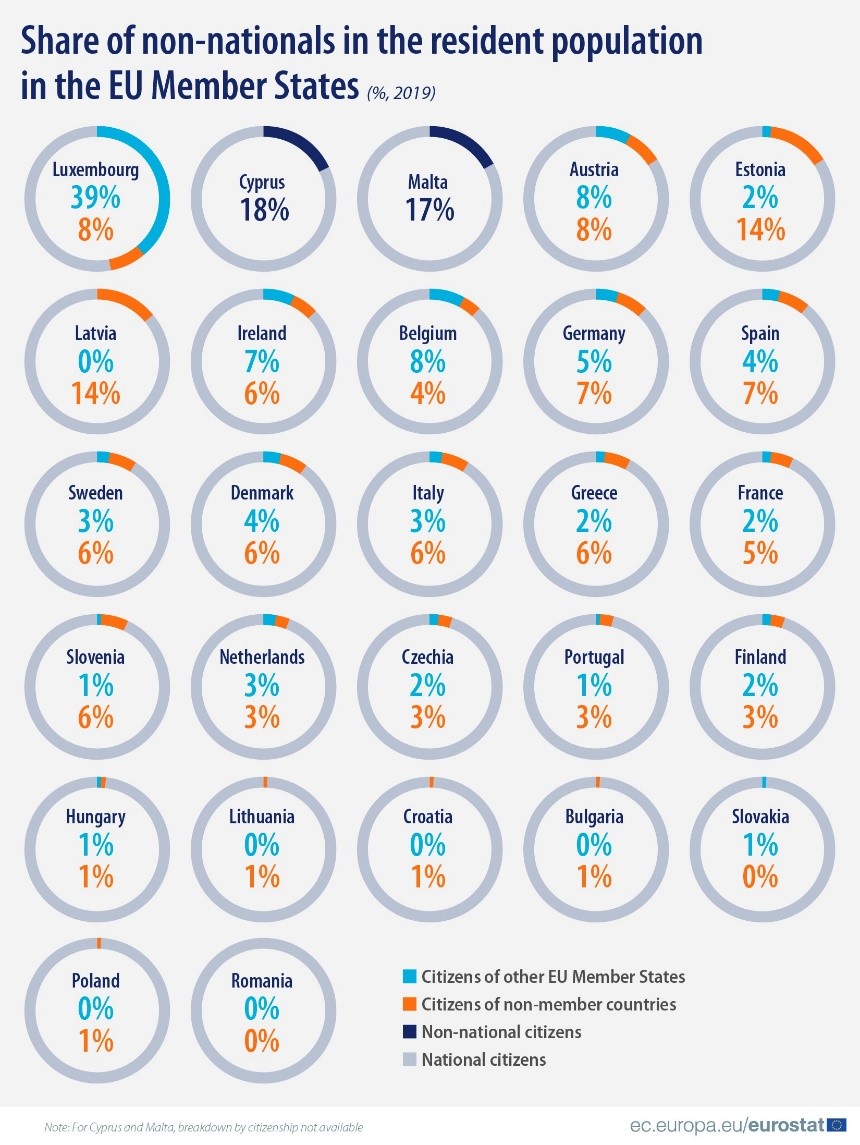
(Source: Eurostat)
According to national statistics published by STATEC (data extracted on 07/01/2022), foreigners made up 47.2% of the general population on 1 January 2021.
Most foreign citizens (87.39%) were European, of which 93.31% were from one of the 27 EU Member States (January 2021).
At that date, there were 244 165 EU citizens, 38.64% of which coming from Portugal (94 335 persons); 19.86% from France (48 502); 9.64% Italy (23 532); 8.03% Belgium (19 613); 5.24% Germany (12 785); 3.13% Spain (7 651); 2.50% Romania (6 096); 2.02% Poland (4 941); 1.69% the Netherlands (4 127), etc.
Natural increase and migration balance
Luxembourg’s population growth is largely due to immigration and to the fertility of the foreign population. Present-day natural increase (excess of births over deaths) is mainly due to the foreign citizens’ young age profile. The death rate has remained relatively low throughout the past decade, while the number of births has significantly risen.
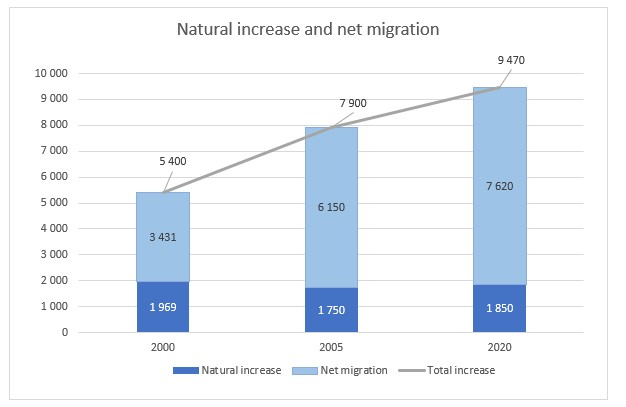
(Source: STATEC, Natural and migratory movements of the population 1891 - 2020, data extracted on 20/01/2022)
The part of foreign citizens in the overall population has been growing consistently since the 1990s, whereas the number of Luxembourg nationals has increased at a slower pace. From 2012 to 2014, the natural surplus (difference between the number of births and the number of deaths) of Luxembourgers recovered from negative figures, in particular due to foreign residents taking the Luxembourg nationality.
Population by age
Total population, Luxembourgers and foreigners per age on 1 January 2021:

(Source: STATEC, Population by age and sex on 1st January 2001-2021, data extracted on 20/01/2022)
Age distribution
The figure below shows the age structure of the population (children, people in working age and third age citizens) in 2001, 2005 and 2021:

(Source: STATEC, Population by age and sex on 1st January 2001-2021, data extracted on 20/01/2022)
The number of senior citizens has been rising during the past decades. However, as a result of the strong net immigration of younger age groups, the share of seniors has been progressing at a relatively moderate pace.
Employment and unemployment
In Luxembourg's labour market, transborder workforce from the neighbouring countries plays an important part. Incoming borderers' numbers outreach by far the numbers of outgoing cross-border workers.
The STATEC map below shows an estimate of cross-border professional mobility in the Greater Region (France, Belgium, Germany, Luxembourg) in 2014:
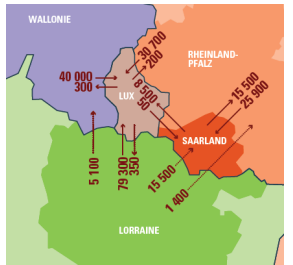
(Source: CES/Transport-Mobilité-Logistique 2017. Perspectives économiques sectorielles. Le transport et la mobilité des personnes aux niveaux national et transfrontalier. [PDF], p. 14)
Cross-border work is reflected in the labour market figures, showing a significant difference between domestic employment (employment in the territory) and national employment (employment of residents).
The labour market overview of the years 2000-2020 shows that not only domestic employment has been rising during the current decade, but also the unemployment rate, from 2.4% in 2000 to 4.1% in 2005 and 6.3% in 2020.
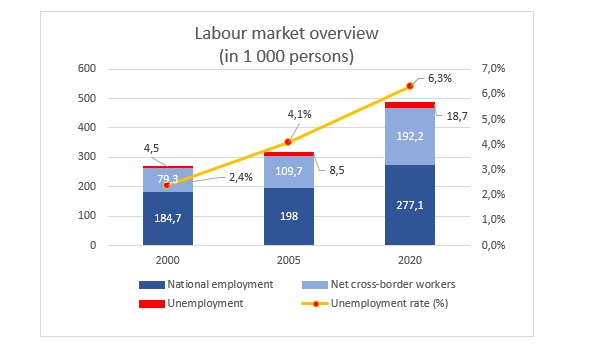
(Source: STATEC, Labour market overview, data extracted on 20/01/2022)
Languages
Official languages
Luxembourg is a trilingual country:
- The national language is Luxembourgish (Lëtzebuergesch), a Moselle-Franconian language. In 2017, the government defined a 40-point strategy for the promotion of Luxembourgish (Une stratégie pour promouvoir la langue luxembourgeoise) as a conclusion of a widespread survey and think tank. Learning Luxembourgish has been gaining momentum in recent years since basic knowledge of the national language is one of the requirements for the acquisition of the Luxembourgish nationality
- The legislative language is French
- The official administrative and judicial languages are French, German and Luxembourgish: administrative requests written in one of these languages have to be answered, as much as possible, in the language chosen by the applicant (law of 24 February 1984 on language regime, Art.4).
French and German are also used for official communications and in the written press. Trilingualism has a long tradition in Luxembourg, with various usages according to social background, context and political situation.
Since 2018 (loi du 23 septembre 2018), the German sign language is also officially recognised for administrative purposes and for education. Hearing-impaired persons are entitled to be taught in sign language and their Luxembourg-resident family members are entitled to be given a total of 100 hours of sign-language lessons.
In addition to the three official languages (Luxembourgish, German and French), the immigrants’ languages (especially Portuguese and Italian, and increasingly English and other languages, play an important role in Luxembourg's economic and cultural life. Code switching, i.e. the necessity to switch from one language to another, is part and parcel of Luxembourg residents' daily life and reflects the diversity of their origins. For Luxembourg, multilingualism is an opportunity and considered to be a vector of social cohesion.
Nonetheless, Luxembourgish remains the most widely spoken language in Luxembourg:
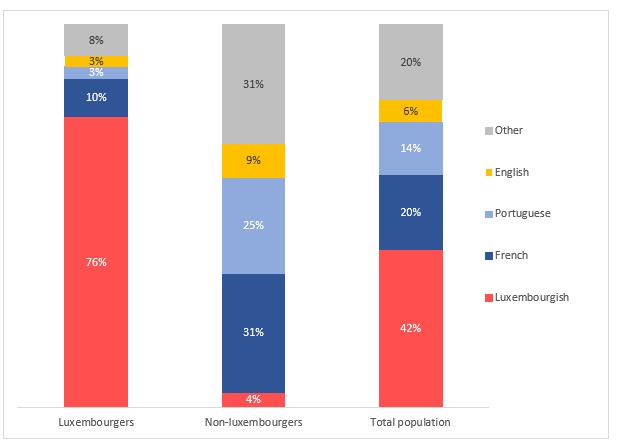
(Source: STATEC, data extracted on 24/01/2022)
Languages at school
The educational system is multilingual. The mainstream national school system uses Luxembourgish as a language of integration and socialisation and progressively adds German, French and English. Additional languages may also be learned.
Formal and non-formal education providers have to offer plurilingual learning.
ECEC providers can only obtain the Education ministry's professional agreement if they fulfil the official requirements, among which the staff's plurilingual qualification is compulsory. Family allowances for ECEC are bound to the provider's official accreditation.
In Early Childhood and School education there are specific support measures for pupils newly arrived in Luxembourg or having difficulties in one or more of the official languages of instruction (see Eurydice article 12.3 Support measures for learners in early childhood and school education).
At secondary school level, some classes provide language teaching for differentiated levels of competence (see Eurydice article 6.2 Teaching and learning in general secondary education).
Luxembourg's public school system also offers alternative pathways based on linguistic preferences.
Alternative organisational variations include, as part of the official school system and free of tuition fees:
- European education: Luxembourg's accredited European Schools offer different language sections (French, German, English)
- International education (in French or English)
- UK-style education
- German-Luxembourgish education.
Compared to other EU member States, Luxembourg is the country where figures are highest concerning the number of pupils using another language at home than the language of instruction, and where the number of teaching hours for foreign languages is the most significant (source: Eurydice Report - Key Data on Teaching Languages at School in Europe 2017, p.11 and 22). The acquisition of linguistic competences plays a central role in school education and in adult education.
Religions
Luxembourg is a secular State. Article 19 of the Luxembourg Constitution guarantees the freedom of worship and public practice of religion, as well as the freedom of expression of religious beliefs. According to article 22 of the Constitution, administrative and financial relationships between the State and religious communities are governed by means of conventions.
The law of 23 July 2016 defines the relations between the State and religions (see legislation: Cults). It also sets the State's financial contribution to the major religions established in Luxembourg: Christian churches (Catholic, Protestant, Orthodox and Anglican) and Jewish and Muslim communities.
Collecting personal information on religious beliefs or activities is formally prohibited in compliance with the law on personal data protection (loi du 1er août 2018). Thus there are no statistics concerning the repartition of the different faiths in the population.
Ethical values are transmitted in school education by a course on moral and social education named 'Life and society' (vie et société). This course approaches cultural, philosophical and religious diversity in a pluralistic perspective. Since the implementation of the 2016 law (loi modifiée du 24 août 2016), this subject is offered at all public schools.
